2.Netty 与 NIO 之前世今生
2.Netty 与 NIO 之前世今生
本文围绕一下几点阐述:
2.1 Java NIO 三件套
2.1.1 缓冲区 Buffer
1.Buffer 操作基本 API

- package com.gupaoedu.vip.netty.io.nio.buffer;
- import java.nio.IntBuffer;
- public class IntBufferDemo {
- public static void main(String[] args) {
- // 分配新的 int 缓冲区,参数为缓冲区容量
- // 新缓冲区的当前位置将为零,其界限(限制位置)将为其容量。它将具有一个底层实现数组,其数组偏移量将为零。
- IntBuffer buffer = IntBuffer.allocate(8);
- for (int i = 0; i < buffer.capacity(); ++i) {
- int j = 2 * (i + 1);
- // 将给定整数写入此缓冲区的当前位置,当前位置递增
- buffer.put(j);
- }
- // 重设此缓冲区,将限制设置为当前位置,然后将当前位置设置为 0
- buffer.flip();
- // 查看在当前位置和限制位置之间是否有元素
- while (buffer.hasRemaining()) {
- // 读取此缓冲区当前位置的整数,然后当前位置递增
- int j = buffer.get();
- System.out.print(j + " ");
- }
- }
- }

2.Buffer 的基本的原理
- hel.
- package com.gupaoedu.vip.netty.io.nio.buffer;
- import java.io.FileInputStream;
- import java.nio.*;
- import java.nio.channels.*;
- public class BufferDemo {
- public static void main(String args[]) throws Exception {
- //这用用的是文件 IO 处理
- FileInputStream fin = new FileInputStream("E://test.txt");
- //创建文件的操作管道
- FileChannel fc = fin.getChannel();
- //分配一个 10 个大小缓冲区,说白了就是分配一个 10 个大小的 byte 数组
- ByteBuffer buffer = ByteBuffer.allocate(10);
- output("初始化", buffer);
- //先读一下
- fc.read(buffer);
- output("调用 read()", buffer);
- //准备操作之前,先锁定操作范围
- buffer.flip();
- output("调用 flip()", buffer);
- //判断有没有可读数据
- while (buffer.remaining() > 0) {
- byte b = buffer.get();
- // System.out.print(((char)b));
- }
- output("调用 get()", buffer);
- //可以理解为解锁
- buffer.clear();
- output("调用 clear()", buffer);
- //最后把管道关闭
- fin.close();
- }
- //把这个缓冲里面实时状态给答应出来
- public static void output(String step, Buffer buffer) {
- System.out.println(step + " : ");
- //容量,数组大小
- System.out.print("capacity: " + buffer.capacity() + ", ");
- //当前操作数据所在的位置,也可以叫做游标
- System.out.print("position: " + buffer.position() + ", ");
- //锁定值,flip,数据操作范围索引只能在 position - limit 之间
- System.out.println("limit: " + buffer.limit());
- System.out.println();
- }
- }
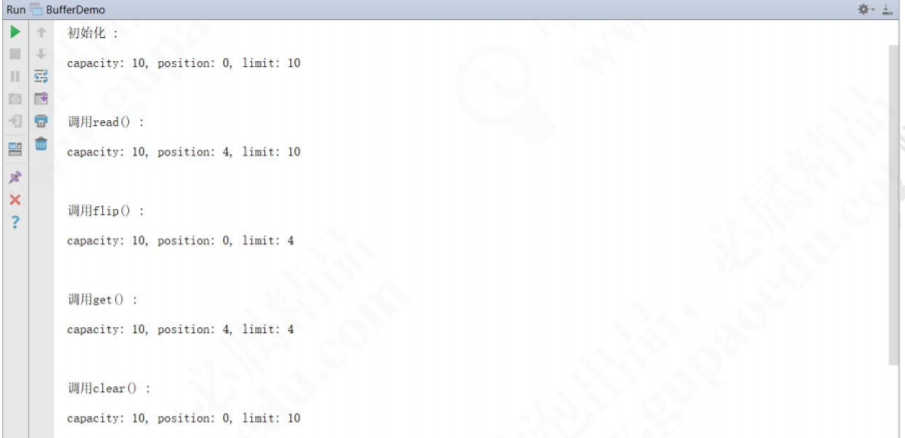
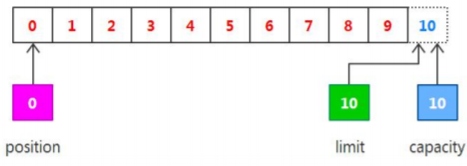
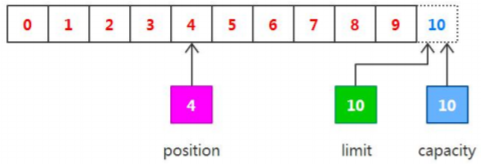
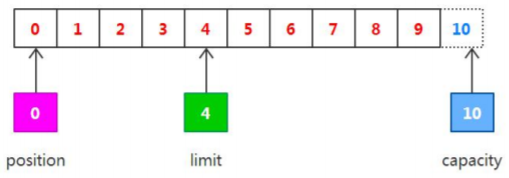

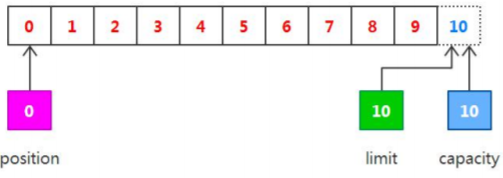
3.缓冲区的分配
- package com.gupaoedu.vip.netty.io.nio.buffer;
- import java.nio.ByteBuffer;
- /** 手动分配缓冲区 */
- public class BufferWrap {
- public void myMethod() {
- // 分配指定大小的缓冲区
- ByteBuffer buffer1 = ByteBuffer.allocate(10);
- // 包装一个现有的数组
- byte array[] = new byte[10];
- ByteBuffer buffer2 = ByteBuffer.wrap( array );
- }
- }
4.缓冲区分片
- package com.gupaoedu.vip.netty.io.nio.buffer;
- import java.nio.ByteBuffer;
- /**
- * 缓冲区分片
- */
- public class BufferSlice {
- static public void main( String args[] ) throws Exception {
- ByteBuffer buffer = ByteBuffer.allocate( 10 );
- // 缓冲区中的数据 0-9
- for (int i=0; i<buffer.capacity(); ++i) {
- buffer.put( (byte)i );
- }
- // 创建子缓冲区
- buffer.position( 3 );
- buffer.limit( 7 );
- ByteBuffer slice = buffer.slice();
- // 改变子缓冲区的内容
- for (int i=0; i<slice.capacity(); ++i) {
- byte b = slice.get( i );
- b *= 10;
- slice.put( i, b );
- }
- buffer.position( 0 );
- buffer.limit( buffer.capacity() );
- while (buffer.remaining()>0) {
- System.out.println( buffer.get() );
- }
- }
- }
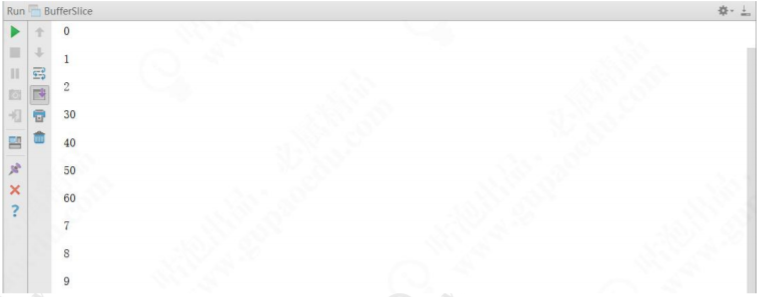
5.只读缓冲区
- package com.gupaoedu.vip.netty.io.nio.buffer;
- import java.nio.*;
- /** 只读缓冲区 */
- public class ReadOnlyBuffer {
- static public void main( String args[] ) throws Exception {
- ByteBuffer buffer = ByteBuffer.allocate( 10 );
- // 缓冲区中的数据 0-9
- for (int i=0; i<buffer.capacity(); ++i) {
- buffer.put( (byte)i );
- }
- // 创建只读缓冲区
- ByteBuffer readonly = buffer.asReadOnlyBuffer();
- // 改变原缓冲区的内容
- for (int i=0; i<buffer.capacity(); ++i) {
- byte b = buffer.get( i );
- b *= 10;
- buffer.put( i, b );
- }
- readonly.position(0);
- readonly.limit(buffer.capacity());
- // 只读缓冲区的内容也随之改变
- while (readonly.remaining()>0) {
- System.out.println( readonly.get());
- }
- }
- }
6.直接缓冲区
- package com.gupaoedu.vip.netty.io.nio.buffer;
- import java.io.*;
- import java.nio.*;
- import java.nio.channels.*;
- /**
- * 直接缓冲区
- */
- public class DirectBuffer {
- static public void main( String args[] ) throws Exception {
- //首先我们从磁盘上读取刚才我们写出的文件内容
- String infile = "E://test.txt";
- FileInputStream fin = new FileInputStream( infile );
- FileChannel fcin = fin.getChannel();
- //把刚刚读取的内容写入到一个新的文件中
- String outfile = String.format("E://testcopy.txt");
- FileOutputStream fout = new FileOutputStream( outfile );
- FileChannel fcout = fout.getChannel();
- // 使用 allocateDirect,而不是 allocate
- ByteBuffer buffer = ByteBuffer.allocateDirect(1024);
- while (true) {
- buffer.clear();
- int r = fcin.read(buffer);
- if (r==-1) {
- break;
- }
- buffer.flip();
- fcout.write(buffer);
- }
- }
- }
7.内存映射
- package com.gupaoedu.vip.netty.io.nio.buffer;
- import java.io.*;
- import java.nio.*;
- import java.nio.channels.*;
- /**
- * IO 映射缓冲区
- */
- public class MappedBuffer {
- static private final int start = 0;
- static private final int size = 1024;
- static public void main( String args[] ) throws Exception {
- RandomAccessFile raf = new RandomAccessFile( "E://test.txt", "rw" );
- FileChannel fc = raf.getChannel();
- //把缓冲区跟文件系统进行一个映射关联
- //只要操作缓冲区里面的内容,文件内容也会跟着改变
- MappedByteBuffer mbb = fc.map( FileChannel.MapMode.READ_WRITE,start, size );
- mbb.put( 0, (byte)97 );
- mbb.put( 1023, (byte)122 );
- raf.close();
- }
- }
2.1.2 选择器 Selector
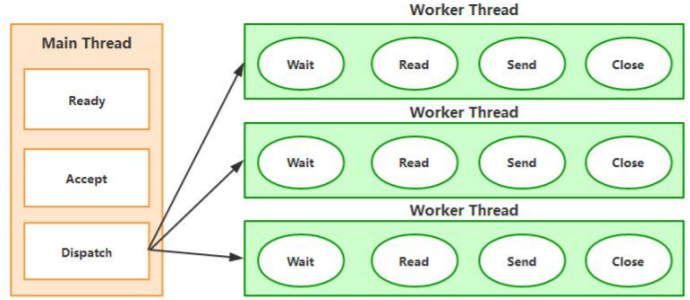
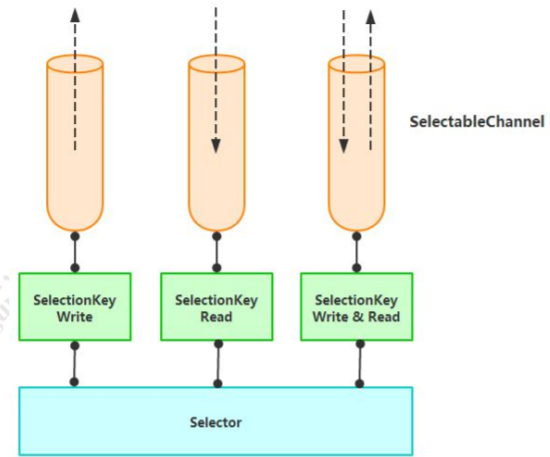
- /*
- * 注册事件
- */
- private Selector getSelector() throws IOException {
- // 创建 Selector 对象
- Selector sel = Selector.open();
- // 创建可选择通道,并配置为非阻塞模式
- ServerSocketChannel server = ServerSocketChannel.open();
- server.configureBlocking(false);
- // 绑定通道到指定端口
- ServerSocket socket = server.socket();
- InetSocketAddress address = new InetSocketAddress(port);
- socket.bind(address);
- // 向 Selector 中注册感兴趣的事件
- server.register(sel, SelectionKey.OP_ACCEPT);
- return sel;
- }
- /*
- * 开始监听
- */
- public void listen() {
- System.out.println("listen on " + port);
- try {
- while(true) {
- // 该调用会阻塞,直到至少有一个事件发生
- selector.select();
- Set<SelectionKey> keys = selector.selectedKeys();
- Iterator<SelectionKey> iter = keys.iterator();
- while (iter.hasNext()) {
- SelectionKey key = (SelectionKey) iter.next();
- iter.remove();
- process(key);
- }
- }
- } catch (IOException e) {
- e.printStackTrace();
- }
- }
- /*
- * 根据不同的事件做处理
- */
- private void process(SelectionKey key) throws IOException{
- // 接收请求
- if (key.isAcceptable()) {
- ServerSocketChannel server = (ServerSocketChannel) key.channel();
- SocketChannel channel = server.accept();
- channel.configureBlocking(false);
- channel.register(selector, SelectionKey.OP_READ);
- }
- // 读信息
- else if (key.isReadable()) {
- SocketChannel channel = (SocketChannel) key.channel();
- int len = channel.read(buffer);
- if (len > 0) {
- buffer.flip();
- content = new String(buffer.array(),0,len);
- SelectionKey sKey = channel.register(selector, SelectionKey.OP_WRITE);
- sKey.attach(content);
- } else {
- channel.close();
- }
- buffer.clear();
- }
- // 写事件
- else if (key.isWritable()) {
- SocketChannel channel = (SocketChannel) key.channel();
- String content = (String) key.attachment();
- ByteBuffer block = ByteBuffer.wrap(("输出内容:" + content).getBytes());
- if(block != null){
- channel.write(block);
- }else{
- channel.close();
- }
- }
- }
2.3.3 通道 Channel
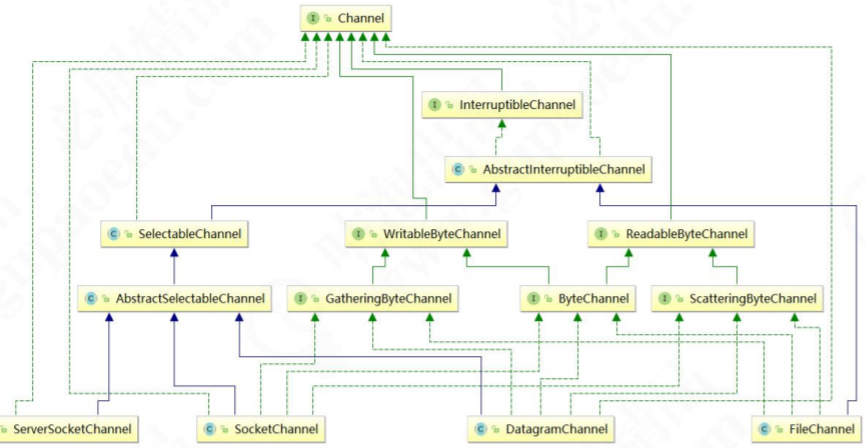
- package com.gupaoedu.vip.netty.io.nio.channel;
- import java.io.*;
- import java.nio.*;
- import java.nio.channels.*;
- public class FileInputDemo {
- static public void main( String args[] ) throws Exception {
- FileInputStream fin = new FileInputStream("E://test.txt");
- // 获取通道
- FileChannel fc = fin.getChannel();
- // 创建缓冲区
- ByteBuffer buffer = ByteBuffer.allocate(1024);
- // 读取数据到缓冲区
- fc.read(buffer);
buffer.flip();- while (buffer.remaining() > 0) {
- byte b = buffer.get();
- System.out.print(((char)b));
- }
- fin.close();
- }
- }
- package com.gupaoedu.vip.netty.io.nio.channel;
- import java.io.*;
- import java.nio.*;
- import java.nio.channels.*;
- public class FileOutputDemo {
- static private final byte message[] = { 83, 111, 109, 101, 32,98, 121, 116, 101, 115, 46 };
- static public void main( String args[] ) throws Exception {
- FileOutputStream fout = new FileOutputStream( "E://test.txt" );
- FileChannel fc = fout.getChannel();
- ByteBuffer buffer = ByteBuffer.allocate( 1024 );
- for (int i=0; i<message.length; ++i) {
- buffer.put( message[i] );
- }
- buffer.flip();
- fc.write( buffer );
- fout.close();
- }
- }
3.IO 多路复用
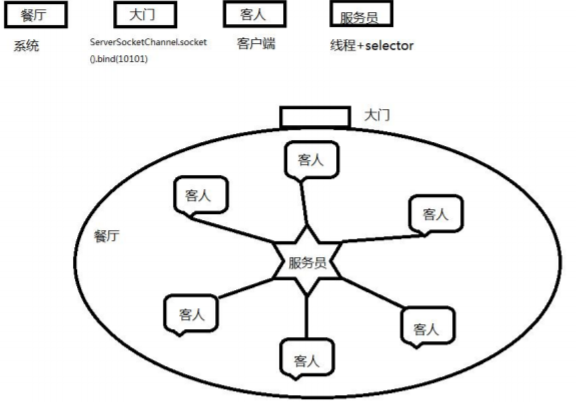
| IO模型 | 相对性能 | 关键思路 | 操作系统 | JAVA支持 |
| select | 较高 | Reactor | windows/Linux |
支持,Reactor 模式(反应器设计模式)。Linux 操作
系统的 kernels 2.4 内核版本之前,默认使用
select;而目前 windows 下对同步 IO 的支持,都
是 select 模型
|
| poll | 较高 | Reactor | Linux |
Linux 下的 JAVA NIO 框架,Linux kernels 2.6 内
核版本之前使用 poll 进行支持。也是使用的
Reactor 模式。
|
| epoll | 高 | Reactor/Proactor | Linux |
Linux kernels 2.6 内核版本及以后使用 epoll 进行
支持;Linux kernels 2.6 内核版本之前使用 poll
进行支持;另外一定注意,由于 Linux 下没有
Windows 下的 IOCP 技术提供真正的 异步 IO 支
持,所以 Linux 下使用 epoll 模拟异步 IO。
|
| kqueue | 高 | Proactor | Linux | 目前 JAVA 的版本不支持。 |
2.4 NIO 源码初探
- public static Selector open() throws IOException {
- return SelectorProvider.provider().openSelector();
- }
- public static SelectorProvider provider() {
- synchronized (lock) {
- if (provider != null)
- return provider;
- return AccessController.doPrivileged(
new PrivilegedAction<SelectorProvider>() {- public SelectorProvider run() {
- if (loadProviderFromProperty())
- return provider;
- if (loadProviderAsService())
- return provider;
- provider = sun.nio.ch.DefaultSelectorProvider.create();
- return provider;
- }
- });
- }
- }
- public AbstractSelector openSelector() throws IOException {
- return new WindowsSelectorImpl(this);
- }
- WindowsSelectorImpl(SelectorProvider sp) throws IOException {
- super(sp);
- pollWrapper = new PollArrayWrapper(INIT_CAP);
- wakeupPipe = Pipe.open();
- wakeupSourceFd = ((SelChImpl)wakeupPipe.source()).getFDVal();
- // Disable the Nagle algorithm so that the wakeup is more immediate
- SinkChannelImpl sink = (SinkChannelImpl)wakeupPipe.sink();
- (sink.sc).socket().setTcpNoDelay(true);
- wakeupSinkFd = ((SelChImpl)sink).getFDVal();
- pollWrapper.addWakeupSocket(wakeupSourceFd, 0);
- }
- public static Pipe open() throws IOException {
return SelectorProvider.provider().openPipe();- }
- public Pipe openPipe() throws IOException {
- return new PipeImpl(this);
- }
- PipeImpl(SelectorProvider sp) {
- long pipeFds = IOUtil.makePipe(true);
- int readFd = (int) (pipeFds >>> 32);
- int writeFd = (int) pipeFds;
- FileDescriptor sourcefd = new FileDescriptor();
- IOUtil.setfdVal(sourcefd, readFd);
- source = new SourceChannelImpl(sp, sourcefd);
- FileDescriptor sinkfd = new FileDescriptor();
- IOUtil.setfdVal(sinkfd, writeFd);
- sink = new SinkChannelImpl(sp, sinkfd);
- }
- /**
- * Returns two file descriptors for a pipe encoded in a long.
- * The read end of the pipe is returned in the high 32 bits,
- * while the write end is returned in the low 32 bits.
- */
- static native long makePipe(boolean blocking);
- JNIEXPORT jlong JNICALL
- Java_sun_nio_ch_IOUtil_makePipe(JNIEnv *env, jobject this, jboolean blocking)
- {
- int fd[];
- if (pipe(fd) < ) {
- JNU_ThrowIOExceptionWithLastError(env, "Pipe failed");
- return ;
- }
- if (blocking == JNI_FALSE) {
- if ((configureBlocking(fd[], JNI_FALSE) < )
- || (configureBlocking(fd[], JNI_FALSE) < )) {
- JNU_ThrowIOExceptionWithLastError(env, "Configure blocking failed");
- close(fd[]);
- close(fd[]);
- return ;
- }
- }
- return ((jlong) fd[] << ) | (jlong) fd[];
- }
- static int
- configureBlocking(int fd, jboolean blocking)
- {
- int flags = fcntl(fd, F_GETFL);
- int newflags = blocking ? (flags & ~O_NONBLOCK) : (flags | O_NONBLOCK);
- return (flags == newflags) ? : fcntl(fd, F_SETFL, newflags);
- }
- /**
- * Returns two file descriptors for a pipe encoded in a long.
- * The read end of the pipe is returned in the high 32 bits,
- * while the write end is returned in the low 32 bits.
- */
- pollWrapper.addWakeupSocket(wakeupSourceFd, 0);
- public static ServerSocketChannel open() throws IOException {
- return SelectorProvider.provider().openServerSocketChannel();
- }
- public ServerSocketChannel openServerSocketChannel() throws IOException {
- return new ServerSocketChannelImpl(this);
- }
- public ServerSocketChannelImpl(SelectorProvider sp) throws IOException {
- super(sp);
- this.fd = Net.serverSocket(true);
- this.fdVal = IOUtil.fdVal(fd);
- this.state = ST_INUSE;
- }
- protected int doSelect(long timeout) throws IOException {
- if (channelArray == null)
- throw new ClosedSelectorException();
- this.timeout = timeout; // set selector timeout
- processDeregisterQueue();
- if (interruptTriggered) {
- resetWakeupSocket();
- return 0;
- }
- // Calculate number of helper threads needed for poll. If necessary
- // threads are created here and start waiting on startLock
- adjustThreadsCount();
- finishLock.reset(); // reset finishLock
- // Wakeup helper threads, waiting on startLock, so they start polling.
- // Redundant threads will exit here after wakeup.
- startLock.startThreads();
- // do polling in the main thread. Main thread is responsible for
- // first MAX_SELECTABLE_FDS entries in pollArray.
- try {
- begin();
- try {
- subSelector.poll();
- } catch (IOException e) {
- finishLock.setException(e); // Save this exception
- }
- // Main thread is out of poll(). Wakeup others and wait for them
- if (threads.size() > 0)
- finishLock.waitForHelperThreads();
- } finally {
- end();
- }
- // Done with poll(). Set wakeupSocket to nonsignaled for the next run.
- finishLock.checkForException();
- processDeregisterQueue();
- int updated = updateSelectedKeys();
- // Done with poll(). Set wakeupSocket to nonsignaled for the next run.
- resetWakeupSocket();
- return updated;
- }
- private int poll() throws IOException{ // poll for the main thread
- return poll0(pollWrapper.pollArrayAddress,
- Math.min(totalChannels, MAX_SELECTABLE_FDS),
- readFds, writeFds, exceptFds, timeout);
- }
- private native int poll0(long pollAddress, int numfds,
- int[] readFds, int[] writeFds, int[] exceptFds, long timeout);
- // These arrays will hold result of native select().
- // The first element of each array is the number of selected sockets.
- // Other elements are file descriptors of selected sockets.
- private final int[] readFds = new int [MAX_SELECTABLE_FDS + 1];//保存发生 read 的 FD
- private final int[] writeFds = new int [MAX_SELECTABLE_FDS + 1]; //保存发生 write 的 FD
- private final int[] exceptFds = new int [MAX_SELECTABLE_FDS + 1]; //保存发生 except 的 FD
- public Selector wakeup() {
- synchronized (interruptLock) {
- if (!interruptTriggered) {
- setWakeupSocket();
- interruptTriggered = true;
- }
- }
- return this;
- }
- // Sets Windows wakeup socket to a signaled state.
- private void setWakeupSocket() {
- setWakeupSocket0(wakeupSinkFd);
- }
- private native void setWakeupSocket0(int wakeupSinkFd);
- JNIEXPORT void JNICALL
- Java_sun_nio_ch_WindowsSelectorImpl_setWakeupSocket0(JNIEnv *env, jclass this,jint scoutFd)
- {
- /* Write one byte into the pipe */
- const char byte = 1;
- send(scoutFd, &byte, 1, 0);
- }
2.5 反应堆 Reactor
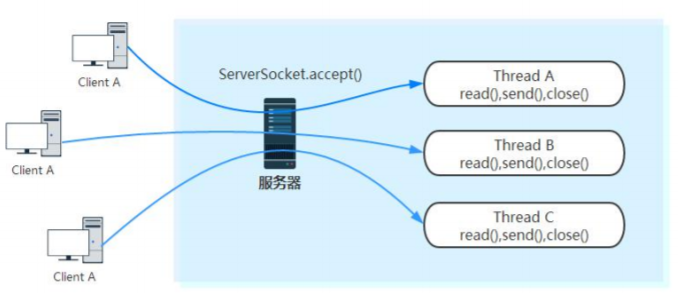
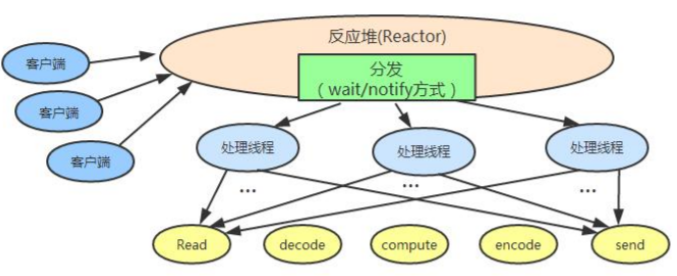
2.6 Netty 与 NIO
2.6.1 Netty 支持的功能与特性
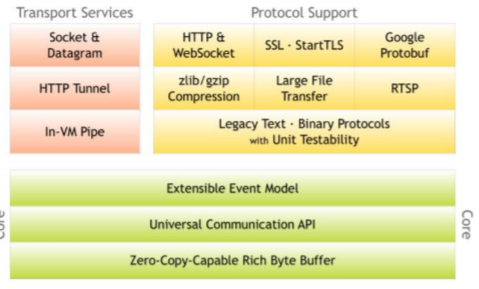
2.6.2 Netty 采用 NIO 而非 AIO 的理由
2.Netty 与 NIO 之前世今生的更多相关文章
- Netty(二)Netty 与 NIO 之前世今生
2.1 Java NIO 三件套 在 NIO 中有几个核心对象需要掌握:缓冲区(Buffer).选择器(Selector).通道(Channel). 2.1.1 缓冲区 Buffer 1.Buffer ...
- android netty5.0 编译时 java.lang.NoClassDefFoundError: io.netty.channel.nio.NioEventLoopGroup
android netty5.0 编译时 java.lang.NoClassDefFoundError: io.netty.channel.nio.NioEventLoopGroup 复制netty包 ...
- 漫谈Java IO之 Netty与NIO服务器
前面介绍了基本的网络模型以及IO与NIO,那么有了NIO来开发非阻塞服务器,大家就满足了吗?有了技术支持,就回去追求效率,因此就产生了很多NIO的框架对NIO进行封装--这就是大名鼎鼎的Netty. ...
- Netty、NIO、多线程
一:Netty.NIO.多线程? 时隔很久终于又更新了!之前一直迟迟未动也是因为积累不够,后面比较难下手.过年期间@李林锋hw发布了一个Netty5.0架构剖析和源码解读,看完也是收获不少.前面的文章 ...
- [netty4][netty-transport]netty之nio传输层
[netty4][netty-transport]netty之nio传输层 nio基本处理逻辑 查看这里 Selector的处理 Selector实例构建 NioEventLoop.openSelec ...
- netty简单NIO模型
首先是使用java原生nio类库编写的例子,开发一套nio框架不简单,所以选择了netty,该例完成后,是netty举例. package com.smkj.netty; public class T ...
- 【Netty】NIO框架Netty入门
Netty介绍 Netty是由JBOSS提供的一个java开源框架.Netty提供异步的.事件驱动的网络应用程序框架和工具,用以快速开发高性能.高可靠性的网络服务器和客户端程序. 也就是说,Netty ...
- Netty与NIO
初识Netty Netty是由JBoss提供的一个Java的开源框架,是GitHub上的独立项目. Netty是一个异步的,基于事件驱动的网络应用框架,用于快速开发高性能.高可靠的网络IO程序. Ne ...
- 基于Netty的NIO优化实践
1. 浅谈React模型 2. Netty TCP 3. Netty UTP
随机推荐
- 一. python 安装
1. 下载安装包 1 2 3 https://www.python.org/ftp/python/2.7.14/python-2.7.14.amd64.msi # 2.7安装包 https: ...
- CI持续集成 -- git 与 gitlab
版本控制系统概述 git Git基本概述 Git是一个免费的开源分布式版本控制系统,旨在快速高效地处理从小型到大型项目的所有内容. Git安装配置 #安装Git yum install -y git ...
- 交互设计算法基础(4) - Hash Table
import java.util.Map; // Note the HashMap's "key" is a String and "value" is an ...
- GoCN每日新闻(2019-09-30)
GoCN每日新闻(2019-09-30) 1. 使用Sqlmock测试数据库 https://medium.com/ralali-engineering/testing-database-using- ...
- mysql e的n次幂exp()
mysql> ); +-------------------+ | exp() | +-------------------+ | 2.718281828459045 | +---------- ...
- C语言函数内局部变量释放的坑
首先把代码贴上来: #include <stdio.h> #include<windows.h> int f(int **iptr){ ; *iptr = &a; ; ...
- 清理系统图标缓存数据库-解决windows图标异常
1.删除C:\Users\用户名\AppData\Local\IconCache.db文件,重建图标缓存 . 一键脚本 taskkill /f /im explorer.exe echo 清理系统图标 ...
- C++之宏、extern关键字与多线程
理解C++ 宏 1.特殊字符 考虑下面的需求,程序中多处使用文本字符串.我们知道文本字符串前后都要加上双引号,我很讨厌输入双引号.有没有好的办法呢?根据常识,使用下面的宏: #define Str(x ...
- java web开发及Servlet常用的代码
日志 1.使用门面模式的slfj,并结合log4j,logback. 2.info.debug.error,要写清楚. 3.使用占位符,如下: log.info("用户id为: {} &qu ...
- ubuntu之路——day15.1 只用python的numpy在底层检验参数初始化对模型的影响
首先感谢这位博主整理的Andrew Ng的deeplearning.ai的相关作业:https://blog.csdn.net/u013733326/article/details/79827273 ...
